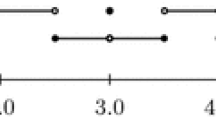Abstract
We introduce a methodology whereby an arbitrary logic system L can be enriched with temporal features to create a new system T(L). The new system is constructed by combining L with a pure propositional temporal logic T (such as linear temporal logic with “Since” and “Until”) in a special way. We refer to this method as “adding a temporal dimension to L” or just “temporalising L”. We show that the logic system T(L) preserves several properties of the original temporal logic like soundness, completeness, decidability, conservativeness and separation over linear flows of time. We then focus on the temporalisation of first-order logic, and a comparison is make with other first-order approaches to the handling of time.
Similar content being viewed by others
Explore related subjects
Discover the latest articles and news from researchers in related subjects, suggested using machine learning.References
BenthemJohanvan, 1983, The Logic of Time. Dordrecht: D. Reidel.
BurgessJ. P. and GurevichYuri 1985, “The decision problem for linear logic”, Notre Dame Journal of Formal Logic 26(2), 566–582.
BurgessJohn P., 1982, “Axioms for tense logic I: ‘Since’ and ‘Until’”, Notre Dame Journal of Formal Logic 23(4), 367–374.
BurgessJohn P., 1984 “Basic tense logic”, pp. 89–133 in Handbook of Philosophical Logic, Volume II, D.Gabbay and F.Guenthner, eds., Dordrecht: D. Reidel.
Casanova, M. A. and Furtado, A. L., 1982, “A family of temporal languages for the description of transition constraints”, in 3rd Worksohp on Logical Bases for Databases, Toulouse, France, December.
Fine, Kit and Schurz, Gerhard, 1992, “Transfer theorems for stratified multimodal logics”, to appear.
Finger, Marcelo, 1992, “Handling database updates in two-dimensional temporal logic”, to appear in J. of Applied Non-Classical Logic.
Fitting, Melvin, 1990, First-Order Logic and Automated Theorem Proving. Texts and Monographs in Computer Science. Springer-Verlag.
GabbayDov M. and HodkinsonIan M., 1990, “An axiomatization of the temporal logic with until and since over the real numbers”, Journal of Logic and Computation 1(2), 229–259.
GabbayDov M., 1987, “The declarative past and the imperative future” in Coloquium on Temporal Logic and Specifications-Lecture Notes in Computer Science 389, B.Banieqbal et al., eds., Manchester: Springer-Verlag.
Gabbay, Dov M., 1990, “Temporal logic, tense or non-tense — inaugural lecture at Imperial College, 17 May 1988”, in Machinations — Computational Studies of Logic, Language and Cognition, R. Spencer-Smith and S. Torrance, eds., Ablex Publishing Co.
Gabbay, Dov M., 1991a, “Labelled Deductive Systems — Part I”, Technical Report CIS-Bericht-90-22, Universität München, Centrum für Informations — und Sprachverarbeitung.
Gabbay, Dov M., 1991b, “Modal and temporal logic programming III—metalevel features in the object level”, in Non-Classical Logic Programming, L. F. del Cerro and M. Penttonen, eds., Oxford University Press.
Gabbay, Dov M., 1991c, Temporal Logic—Mathematical Foundations and Computational Aspects. to appear.
Gabbay, Dov M., 1991d, “Theoretical foundations for non-monotonic reasoning Part 2: Structured non-monotonic theories”, pp. 19–40 in SCAI 91-Third Scandinavian Conference on AI.
Gabbay, Dov M., 1992, “Fibred semantics and combinations of logics”, Manuscript, Imperial College.
GarsonJames W., 1984 “Quantification in modal logic”, pp. 249–307 in Handbook of Philosophical Logic, Volume II, D.Gabbay and F.Guenthner, eds., Dordrecht: D. Reidel.
Halpern, Joseph Y. and Moses, Yoram, 1985, “A guide to the modal logics of knowledge and belief”, pp. 480–490 in Proceedings of the 9th International Joint Conference on Artificial Intelligence (IJCAI-85).
Hintikka, Jaakko, 1962, Knowledge and Belief, Cornell University Press.
Hughes, G. E. and Cresswell, M. J., 1968, An Introduction to Modal Logic, Methuen.
Konolige, K., 1986, A Deductive Model of Belief, Research notes in Artificial Intelligence, Morgan Kaufmann.
KrachtMarcus and WolterFrank, 1991, “Properties of independently axiomatizable bimodal logics”, Journal of Symbolic Logic 56(4), 1469–1485.
Quine, Willard Van Orman, 1960, Word and Object, MIT Press.
Reynolds, Mark A., 1992, “An axiomatisation for until ans since over the reals without the IRR rule”, to appear in Studia Logica.
ThomasonRichmond H., 1984, “Combinations of tense and modality”, pp. 135–165 in Handbook of Philosophical Logic, Volume II, D.Gabbay and F.Guenthner, eds., Dordrecht: D. Reidel.
XuMing, 1988, “On some U, S-tense logics”, Journal of Philosophical Logic 17, 181–202.
Author information
Authors and Affiliations
Rights and permissions
About this article
Cite this article
Finger, M., Gabbay, D.M. Adding a temporal dimension to a logic system. J Logic Lang Inf 1, 203–233 (1992). https://doi.org/10.1007/BF00156915
Received:
Accepted:
Issue Date:
DOI: https://doi.org/10.1007/BF00156915




